Author(s): Akio Tateya
ABSTRACT
When plants are imported from abroad, they are subject to plant quarantine at the entry because of the protection from pest invasion, spread and establishment in the country. When plant inspector intercepts quarantine pest, he orders to disinfest pest. In the disinfestation methods there are various ways available to the pests. Currently methyl bromide fumigation treatment is popular because of the secure disinfestation effectiveness, simple treatment operation and economic feasibility.
However, methyl bromide is under the control of the Montreal Protocol on the substances that deplete the ozone layer. Methyl bromide (MB) for soil treatment and pest disinfestation of commodity of non-quarantine pest, post harvested products and the structure is already phased out. Methyl bromide for those uses is not allowed.
Methyl bromide for the use of quarantine and pre-shipment (QPS) treatment is exempted from the control. Currently annual global consumption stays at high level. Therefore, it is concerned with the impacts to the ozone layer and expected to reduce by the use of alternatives to methyl bromide. According to Decision XX/6 of the Montreal Protocol, the use and emission of MB in the quarantine and pre-shipment treatment is suggested to reduce as much as possible to adopt alternative.
In this paper, it is shown alternatives currently available in the quarantine treatment in Japan and appropriate use of methyl bromide in the fumigation treatment with secure disinfestation effectiveness to the pests and the less emission to the atmosphere at the end of treatment.
Alternatives to methyl bromide applied in the quarantine treatment in Japan are mainly aluminum phosphide and carbon dioxide fumigation to treat grain, methyl iodide fumigation for timber and wood, system approach for the import of cherry fresh fruit from US and New Zealand and heat treatment of Kiln dry to wood packing materials for export etc. They are all authorized as a disinfestation treatment.
Methyl bromide is exclusively registered for quarantine treatment and not allowed for other uses. Dose rates for grain are prescribed in fumigation standards to ensure the disinfestation effectiveness and minimum emissions to the atmosphere. Dose rate is dependent on the various factors such as for bagged grain in a chamber or bulk grain in a silo, plant gas absorption, fumigation duration time, kinds of quarantine insect pest, gas retention capability of fumigation chamber, gas circulation system, grain temperature and grain loading rate. The majority of fumigation chambers for quarantine treatment are of high level of gas retention ability and have good airtightness which is expected to give the minimal emissions of MB to the atmosphere. Lists of quarantine and nonquarantine pests are established in accordance with the pest risk analysis mentioned in the International Standards for Phytosanitary Measure (ISPM)-15 issued by International Plant Protection Convention (IPPC).
Aluminum phosphide is used for the pest insects in the grain consignment of bags in chamber and bulk in silo. When aluminum phosphide is exposed with air moisture, it generates PH3 of active gradient with following formula.
AlP + 3H 2 O -Al(OH)3 + PH3
Dose rate is equivalent to PH 3 . Dose rate for wheat in bags in chamber is 0.5 g/m 3 PH3 of high air tightness of chamber of super A and A class with the treatment duration time of 5 days under more than 20 degrees centigrade (°C). Tablets are put on the top of bags or on the floor and left phosphine gas generated. Dose rate for wheat in bulk in silo is 2.0 g/m3 PH3 with the treatment duration time of 3-5 days under more than 20 °C. Aluminum phosphide tablets are given along the grain input from top of the silo. Aluminum phosphide is also approved for the treatment of the seed pest insects. It is applied at the dose rate of 0.5 g/m 3 PH3 for 5 days in the chamber of air tightness of the class of super A or A under more than 20 °C.
It is aimed at time and labor saving for aluminum phosphide fumigation treatment. Phosphine gas generator is useful of the shorter fumigation time and labor saving. Dose rate for bags in the chamber and for bulk in the silo is 1.0 g/m 3 PH 3 for 2 days. It does not remain debris of aluminum hydrogen oxide Al (OH3) in the grain layer.
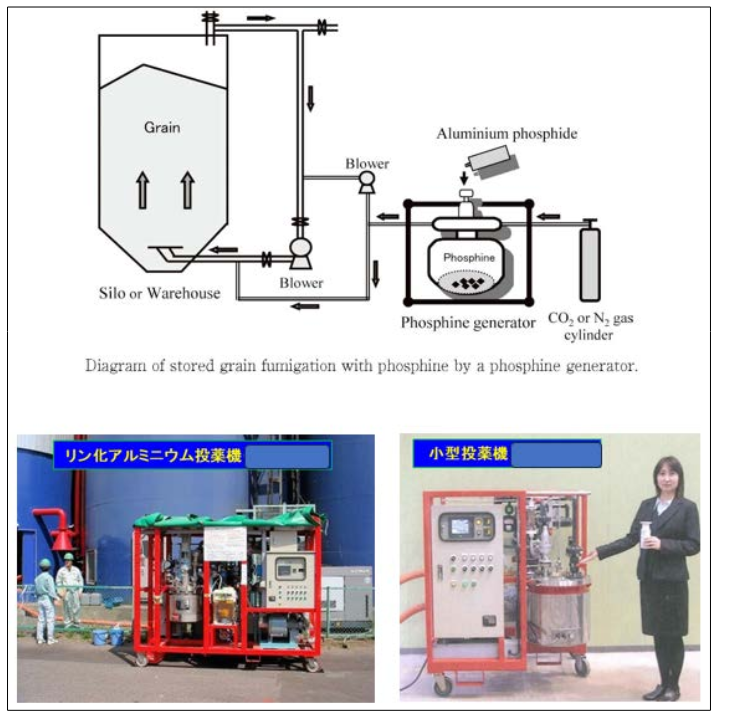
It is attached to fumigation chamber and silo facility. Tablets of aluminum phosphide are put in the gas generator. Then phosphine gas is generated and sent to the inside of chamber or silo with the stream of nitrogen or carbon dioxide and to the grain layer with the conventional gas circulation system. Operation of gas generation system is contributed to be shorter dose application time and to make dose rate less (2.0 g/m 3 - 1.0 g/m 3 ) and fumigation duration time shorter (3-5 days at 25°C - 2 days). Residual debris of aluminum hydrogen oxide Al (OH)3 in the bottom of the gas generator is removed later and could be disposed safely. Consignee appreciates less expense with less dose rate and shorter fumigation treatment time. It is popular among the consignees.
A series of paper bags of aluminum phosphide powder are suspended in the space above the grain layer. They are put down from the opening at the top of silo. Then opening hole is closed. At the end of fumigation treatment, paper bags of residual debris are taken out and removed away and safely disposed. Fumigation condition is prescribed of dose rate of 2g/m 3 for 3 days under more than 20 °C. When aluminum phosphide contacts the with air moisture in the space of silo, phosphine gas starts to generate. For the uniform gas diffusion in the grain layer, it needs gas circulation through the grain layer at least one hour per day. Aluminum phosphide powder in the paper bags suspending system is good for shorten fumigation duration time and no residue debris remaining in the grain. And this system does not need worker during dose application. It saves labor. This system does not need any apparatus such as extra gas generation system either.
However, it is noted that if the space above the grain layer is small, phosphine gas concentration goes up to the dangerous level to ignite because of the phosphine gas properties of easy ignition at the level of 1.8 % in the air. Therefore, it needs more than 15% space of the silo inside volume. It is also noted that when temperature in the space is less than 10°C, aluminum phosphide might not be decomposed completely by the end of fumigation duration time. Therefore, it must be careful to dispose residue debris for workers not to be exposed with phosphine gas.
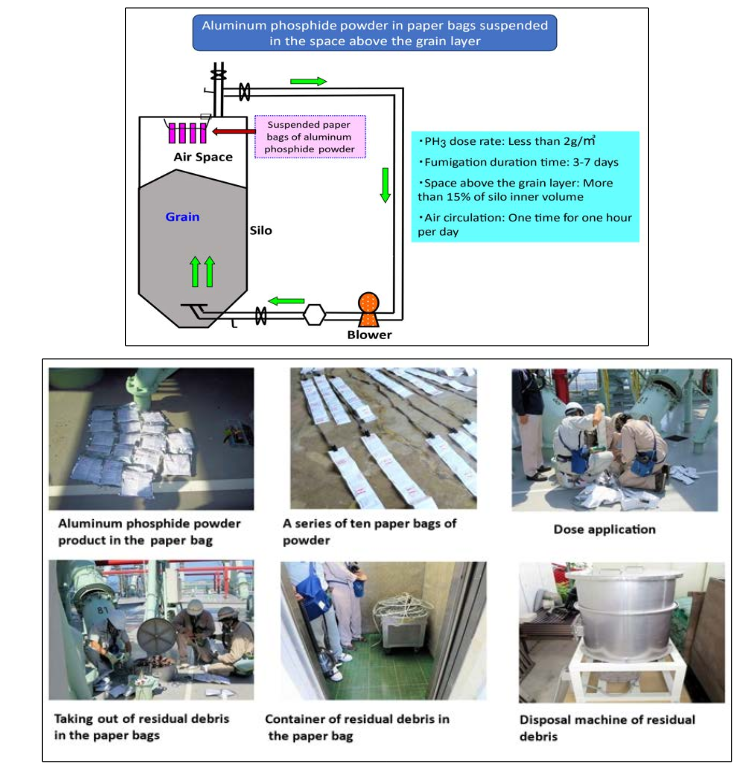
Plant inspector has got used to find many alive non-quarantine pests in the wheat in bulk on board. He found much of residual debris of aluminum hydrogen oxide Al (OH) 3 on the top of grain layer. And he found many alive pests over there too. Consignee asked pest control operation with the fumigation of aluminum phosphide but later on he was informed of the failure of fumigation treatment with many pests still remaining alive in the grain. He realized pesticide resistance could be endowed to the pest insects. Consignee has found no way to disinfest those pest insects and to deliver those consignment free from pests to the users. He realized that aluminum phosphides were not applied uniformly in the grain and pupae could be left alive to metamorphose to the adults because pupae have stronger resistance to the phosphine gas. It is suggested that aluminum phosphide should be applied uniformly in the grain layer for complete disinfestation otherwise alive pests could be endowed more resistance and no way to disinfest.
It is used for grain in bag for chamber and in bulk for silo. Fumigation facilities is in the rank of Super A class. According to the extract of the fumigation standard, carbon dioxide is put up to 50% of the inner volume of fumigation facility and fumigated for 10 days under more than 25°C.
Methyl iodide was registered as pesticide and approved as the alternative to disinfest wood and timber for quarantine treatment. It was also registered to sterilize chestnut weevil in the chestnut fresh fruit for the post-harvest treatment. Japan had submitted MB critical use nomination (CUN) from 2005 for the fumigation of chestnut and phaseout CUN in 2014 with the availability of methyl iodide. It is applied registration for the fumigation to the vegetable of pumpkin, asparagus and broccoli because methyl bromide use is not allowed to apply to these plants even as quarantine treatment due to no room of acceptable daily intake of 50 mg/man/day.
Methyl iodide fumigation trial had been done to the apple for the aim of disinfestation of peach fruit moth. Soma et al. conducted a series of mortality tests to establish methyl iodide phytosanitary fumigation standards against the peach fruit moth, Carposina sasakii infesting apple [1]. Aged instar larvae which are most tolerant stage to methyl iodide fumigation infesting the ‘Fuji’ variety packed in export cartons were fumigated at 20 and 23 g/ m 3 for 2 hours at 15°C with the loading rate of 0.12 t/m 3. A total of 37,002 larvae was completely killed in 52 replications. No chemical injury was observed in 6 major apple varieties. The residual methyl iodide in the fruit was less than the quantification limit of 0.01ppm in 3 days after fumigation.
According to International Standards of Phytosanitary Measures (ISPM) 15 of International Plant Protection Convention (IPPC), wood packing materials for export should be disinfested prior to export [2]. Japan government, Ministry of Agriculture, Forestry and Fisheries has established disinfestation certificate system and registered two certifying organizations of Japan Plant Quarantine Association and Japan Lumber Inspection & Research Association to operate undertaking for disinfestation certificate, based on “The Regulation for the Disinfestation on Exporting Wooden Packing Material”. Japan government had strongly suggested to use heat treatment and not to use methyl bromide except for the inevitable cases such as consignment is already packed. Heat treatment is so-called Kiln dry treatment and its standard is of 56 °C in the center of the wooden packing for 30 minutes.
In Japan heat treatment is used for the majority of disinfestations of wood packing material and methyl bromide fumigation is used only 1225kg in 2022 (personal communication).
US cherry fresh fruit is not allowed to import to Japan because of possible introduction and distribution of codling moth. However, those cherry fruits are allowed to import with lifting ban under the conditions that cherry fruits are treated with methyl bromide fumigation. Then Animal and Plant Health Inspection Service (APHIS) of United State of Department of Agriculture (USDA) proposed that instead of methyl bromide fumigation treatment, system approach could be applied to lift ban of cherry fresh fruit import from United States of America. Cherry fresh fruits could be regarded as being free from the pest under the conditions that growing areas for the export to Japan is designated where codling moth could be hardly found with the lure trap survey by US and no pests should be found in the cherry fruits at all. Japan agreed with the US proposal of system approach under the conditions that it is certified that they are produced in the designated area where no more than ten codling moths in the designated growing area in the State of California and thirty codling moths in the State of Idaho, Oregon and Washington are caught with the lurk trap for the period of one week and no codling moth is found in the cherry fruit survey
New-Zealand cherry sweet fruit export to Japan was also admitted by MAFF Japan government [3]. New Zealand gave the evidence that cherry sweet fruit is the poor or non-host plants of codling moth. New Zealand had given the evidence that cherry fresh fruit is not the preferable host plant to codling moth. NZ cherry fresh fruit of which growing area is designated by NZ plant quarantine authorities is also imported without MB treatment.
This is the cases that system approach was applied as the alternative of methyl bromide fumigation treatment.
When corn is imported as the material of corn starch and quarantine pests are intercepted, it is allowed not to be fumigated but to be put it under processing treatment. Processing treatment is regarded as quarantine treatment. Pest animals is supposed to be disinfested during corn starch processing. It saves methyl bromide use.
MB fumigation as a phytosanitary treatment must strictly and exclusively be applied for those consignments in which quarantine pest insects are intercepted. It is provided in MBTOC 2014 Assessment Report as the minimum use of methyl bromide in plant quarantine treatment in Japan (UNEP 2014) [4]. In this report, various information since then are added for making clear of current situation.
Methyl bromide should not be used to non-quarantine pests. Non-quarantine pests of injurious animal are listed of 424 species updated in February 28th 2023 by pest risk analysis (PRA) based on ISPM-2. Many species of grain pests are now included in this list. As a result, MB consumption volume has been significantly small.
Improving Pest Identification Skills of Plant Quarantine Inspectors
Plant quarantine inspector (PQI) is strictly expected to order disinfestation to quarantine pests and not to order to non-quarantine pests. PQI has to identify certainly whether quarantine pest or nonquarantine. PQI attends training sessions on pest identification whether these are classified as quarantine or non-quarantine pests.
MB was registered in December 24th 1994 for exclusive use as a quarantine treatment. MB for quarantine treatment is not allowed for soil or post-harvest treatment. It is clearly identified with a red label on the cylinder for easy recognition. In the pest control operation this regulation is strictly observed not to used other treatment. It is indicated in the label that MB should be used only for quarantine treatment.
Montreal Protocol urges all Parties to make effort to reduce the amount of MB consumption for the quarantine treatment with Decision VI/11(c) and XX/6. Japan has made much effort to use MB appropriately. In the table below Japan MB consumption is shown.
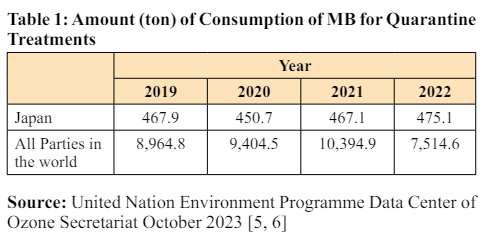
It includes the various measures such as establishment and update of non-quarantine pest list, designation of fumigation chamber in view of the airtightness for high gas retention capability and establishment of fumigation standard.
Fumigation standard provides dose rates in response to the various fumigation factors such as gas retention capability of the chamber, MB adsorption by plant, bag in chamber or bulk in silo, fumigation duration time, temperature, consignment loading rate and air circulation system, High gas retention capability is very significant to control pests and to reduce MB emission to the atmosphere.
It is crucial to keep high gas retention capability of the fumigation facility. Fumigation chambers for quarantine use are designated by Plant Protection Station, MAFF with the category class super A, class A, class B and class C according to gas retention capability [3]
Fumigation chambers for plant quarantine treatment are categorized with their gas retention capability. They are ranked as class Super A, class A, class B or class C designated by Plant Protection Station. The gas retention capability is determined with input of dose rate of 10 g/m3 in the empty chambers and checked gas concentration remaining 48 hours later. If remaining gas concentration is recognized higher than 85% of the initial dose rate, the chamber is designated in the category of class Super A; if remaining gas is recognized over 70%, the chamber is designated in the category of class A; if remaining over 55%, the chamber is designated in the category of class B and if over 40%, it is designated in class C. Chambers with a gas concentration below 40% are not allowed for quarantine fumigation treatments. Currently 99.7 % of the chambers are of super class A and class A. There are no chamber of class C being designated for phytosanitary fumigation treatment.
Plant Protection Station conducts air tightness tests to determine whether a chamber is fit for quarantine treatments. For the fumigation chamber, it is sealed and air is introduced into an empty premise until an air pressure shows 55 mm Aq. of the water manometer. And it is left until the pressure goes down to 50 mm Aq. If five minutes later pressure is found more than 45 mm Aq., the chamber is categorized as class Super A. If pressure is found between 45 mm and 5 mm Aq., the chamber is classified as class A.
For silos, the air pressure is raised up to 550 mm Aq. with the air introduction into the empty silo. Once sealed, pressure is let descent. When pressure is shown from 500 mm Aq. to more than 400 mm Aq. at 20 minutes later, the silo is designated as the category of class Super A. When pressure come down from 500 mm Aq. to the pressure down between 200 mm Aq. and 400 Aq. at 20 minutes later, it is classified as class A.
Designation of fumigation chamber is based with either gas retention ability test or air tightness test.
Number of chamber and silo and their total space size in each gas tightness category are shown in the tables below.
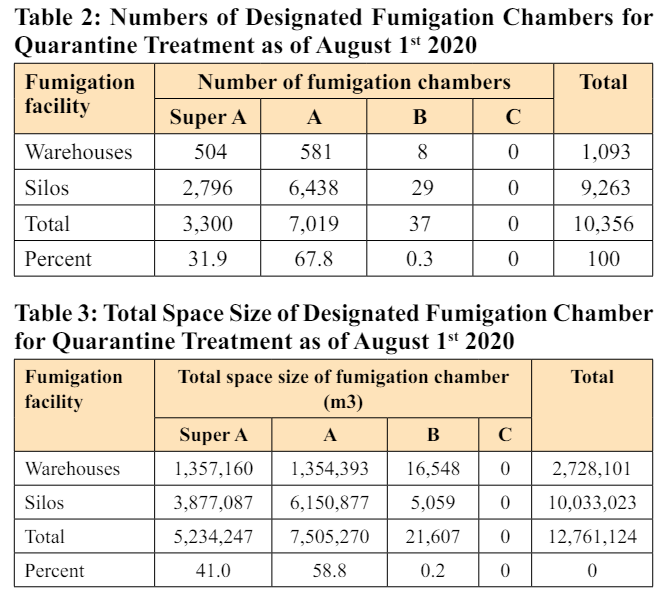
MB dose rates are prescribed in the fumigation standard to ensure complete disinfestation under various fumigation conditions as shown in table 4 [3]. They are respectively set under consideration of various fumigation factors:
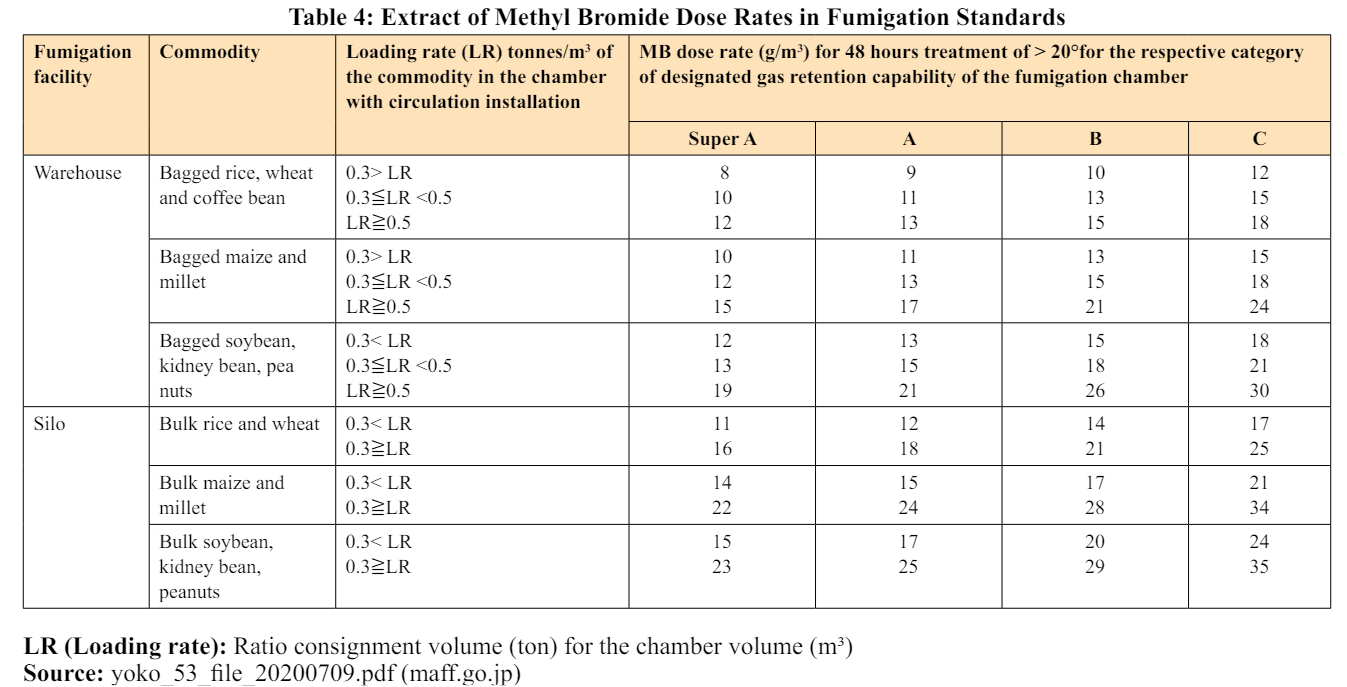
Fumigation chambers for quarantine use are designated by Japan MAFF as category class super A, class A, class B and class C with the various parameters [7, 8]. The higher the gas retention capability of the chamber, the smaller the dose rate applied.
Dose rates vary depending on the fumigation duration time of 24 h, 48 h or 72 h. The longer the fumigation, the smaller dose rate is applied. A 48-h fumigation time is presently preferred in view of fumigation costs.
The fumigant penetrates and spreads easier throughout the grain in bag rather than in bulk. The dose rate for grain in bags in chamber is thus lower than for bulk grain in silos.
The dose rate is set in consideration of the level of MB absorption by plant products, being smaller absorption of the plant with lower dose rate. For example, dose rates for soybeans are higher than for wheat because the former tend to absorb more MB due to their higher protein content. Dose rates for wheat flour are higher than for wheat grain because flour absorbs more MB than grain.
Pests are more sensitive to MB at higher temperatures. Dose rates are thus set depending on the grain temperature of <10°C, 10°C-20°C and > 20°C.
The loading rate (LR) is expressed in terms of tonnes/ m 3 . MB is absorbed much in the large volumes of grain. So higher dose rate is necessary for effective insect disinfestation. Dose rates are set at the load rate of <0.3 t/m3 , 0.3 - 0.5 t/m3 and >0.5 t/m3 for flat fumigation chambers and <0.3 t/m3 and >0.3 t/m3 for silos.
Currently, circulation systems are installed in the majority of fumigation chambers in Japan.
Various additional measures have been taken to minimize the use and emission of MB.
When Plant quarantine inspector recognizes fumigation, treatment is not carried out properly such as recognition of surviving pests or lower gas concentration than the required level, he orders to disinfest again. In this case, methyl bromide repeated use is not allowed. Consignee should show the alternative treatment such as aluminum phosphide or carbon dioxide. Otherwise, custom clearance is denied and re-shipment to another country or destruction of the consignment is the only option.
The MB application dose is set in accordance with the volume of the fumigation chamber, not the volume of the consignment. To the small size of consignment, it is recommended not to use large chamber.
If plant products with different MB absorption rates are mixed loaded, the dose rate is set in accordance with the plant category with higher absorption rate no matter how the consignment size is small. Therefore, it is strongly recommended to put them separate chambers.
It may give opportunity to realize what issues are existing for the reduction of consumption of MB for quarantine use and acceleration of adoption of alternatives to MB for QPS. In Japan methyl bromide is used very appropriately. Its consumption volume is accounted 475.1 tonnes in 2022. Alternatives are also applied in the quarantine treatment.
Looking at the MB consumption of the overseas countries, its volume stays at higher level. It is seemed the reasons why methyl bromide use is rather convenient and reliable to control pest insects with simple dose application, short fumigation duration time and good cost performance. For more reduction of the consumption of MB for quarantine use, it particularly needs improvement of gas retention capability of the chamber for good efficacy and for less leakage from the chamber. It is thought that in the overseas countries, gas retention capability of the chamber is not necessarily seemed adequate. In their pest control operation, methyl bromide is applied at very high level to kill pest completely with the compensation for large leakage from the chambers. Therefore, improvement of gas retention capability is seemed be top priority. In addition, fumigation standards should be established for dose rate. With improvement of chamber gas retention capability and establishment of fumigation standard, it could be achieved the complete pest disinfestation and the least emission of methyl bromide to the atmosphere.
On the other hand, there seem to be barrier to replace methyl bromide with alternatives. It needs more specific quarantine level efficacy data, pesticide registration, economic feasibility of cost performance, residue survey for mitigating anxiety of the consumers, training on safe handling and management in the pest control operation (UNEP TEAP Progress Report 2023) [8].
For the settlement of those issues, it is highly important that national plant protection organization (NPPO) takes leadership to instruct appropriate use of methyl bromide and alternatives to the consignee, fumigation chamber owner and pest control operator. It could be expected to prioritize with NPPO in those countries of high level of methyl bromide consumption in quarantine treatment.
